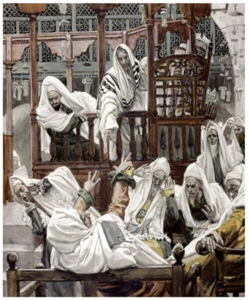January 31, 2021
Reading of the Prayer List
Sermon from Mark+
Sunday Sermon
Fight Scene
The Rev. Mark R. Sutherland
TEASER TEXT
What have you to do with us Jesus of Nazareth? Have you come to destroy us? We know who you are the Holy One of God.
SERMON TEXT
Chapter 1 of Mark’s gospel moves at a breath-taking pace. For Mark there is not a moment too soon; there is no time to lose. In verses 21-28, he ushers us into a scene of some significance. Matt Skinner notes that: Possessed by the Holy Spirit, fresh from successfully confronting Satan in the wilderness, preaching the reign of God, and now in the company of at least four followers, it’s time for Jesus’ public ministry to gather momentum. In other words, it’s time for a fight scene. The scene takes place in the synagogue where we find Jesus preaching to the gathered congregation. Within the congregation Mark tells us there are two different sets of ears who receive Jesus message very differently.
Mark describes Jesus as teaching with authority and he uses the word exousia to describe the effect of Jesus’ teaching upon his hearers. In the ears of the congregation Jesus’ teaching provokes utter astonishment causing them to exclaim – what is this? A new teaching – and with authority. Stephen Hultgren sums it up nicely when he says that in other words, exousia is the “sovereign freedom” of one who acts without hindrance. Immediately they hear in Jesus’ teaching a breaking free of the constraints imposed by the conventional scribal hedging – their umming and aahing of Torah interpretation.
From exousia we get our English word exorcism – which means to bind with authority. The ears of the demons inhabiting the man with an unclean spirit(s) are provoked by Jesus teaching to cry out -what have you to do with us Jesus of Nazareth? Have you come to destroy us? We know who you are the Holy One of God. Matt Skinner notes that the teaching and the exorcism are connected since both result in amazement and acclamations about Jesus’ authority.
However, there is a third set of ears to consider. How do we hear Jesus teaching in Mark 1:21-28? This immediately raises the thorny question of what are we to make of the many biblical stories of exorcism as in Mark 1:21-28?
For us, biblical stories about demon possession echo a pre-scientific mindset in which physical affliction is credited to the action of spiritual forces. We, on the other hand, understand these afflictions as the result of physical or psychological causes. As the heirs of Enlightenment rationalism, we no longer believe in demons or resort to demonology as a causal explanation for human behavior or suffering. By and large we think this is a good thing too!
But even from our seemingly confident 21st-century world view things are not so simple. We are increasingly living into a world that is well and truly beyond the modern-rationalist reductionism that dominated 20th-century thought which arrogantly assumed that given time, all challenges could be brought under human control. We are truly experiencing life in a post-modern world – a world of pandemic and the return of the dynamics and phobias of a global plague; a world which confronts us with a host of issues – spiritual, sociological, anthropological, habitual, political, biological, climatological; issues so interconnected that we are not even capable of so neatly dividing them into such categories. The common feature of all these issues is that they appear to remain stubbornly beyond our ability to control.
In Mark’s story we should notice that the demons are not free-floating spirits, but are embodied spirits. Jesus does not destroy them, he disembodies them.
It is no accident that Mark chooses an exorcism to inaugurate Jesus public ministry. The importance of such a story for us lies not in its cause-and-effect attribution to evil forces.
Mark relates and event that still speaks to us of our experience of forces that are beyond our control -because- they are embodied within us.
So here’s the point about the host of issues – spiritual, sociological, anthropological, habitual, political, biological, climatological; issues so interconnected that we are not even capable of so neatly dividing them into such categories – is not just that they remain stubbornly beyond our ability to control but that they continue to exercise power over us through their embodiment within us.
In binding evil, Jesus strips the spirits of their human embodiment denying them the capability to have a settled place or entrenched influence in the world. Jesus confronts the power of evil not by eliminating it but by banishing its individual and systemic embodiment from human affairs. As his followers we are called to likewise confront and bind – banish all those isms of race, ethnicity, gender, identity, privilege, and environmental denial; to strip these evil spirits from their embodiment in our individual and social lives. At the heart of this host of isms we find enthroned the most corrosive isms of all – skepticism and cynicism.
Of all the gospel writers, within the scope of his first chapter Mark most concisely and clearly declares the priorities with which Jesus inaugurates his announcement of the kingdom. After calling others to join him and to share his ministry he initiates a confrontation with the forces of evil – denying them embodiment from which they draw the power to hold ultimate sway over our lives.
Can there be any confusion in our minds about what it means to hear the call to come: come follow me and to go and do likewise?


 Liminalsolutions.com
Liminalsolutions.com